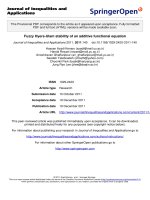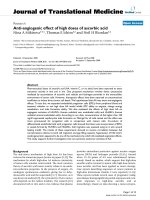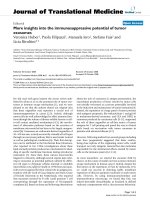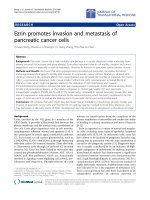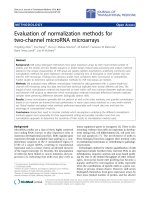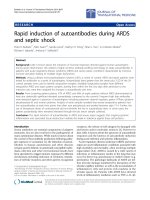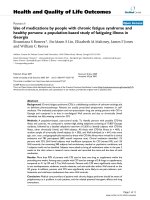Báo cáo hóa học: " Thermosensitive Nanocables Prepared by Surface-Initiated Atom Transfer Radical Polymerization" ppt
Bạn đang xem bản rút gọn của tài liệu. Xem và tải ngay bản đầy đủ của tài liệu tại đây (357.21 KB, 6 trang )
NANO EXPRESS
Thermosensitive Nanocables Prepared by Surface-Initiated Atom
Transfer Radical Polymerization
Qingshan Wei Æ Wenbo Zhou Æ Jian Ji Æ
Jiacong Shen
Received: 6 October 2008 / Accepted: 30 October 2008 / Published online: 19 November 2008
Ó to the authors 2008
Abstract Thermosensitive nanocables consisting of Au
nanowire cores and poly(N-isopropylacrylamide) sheaths
(denoted as Au/PNIPAAm) were synthesized by surface-
initiated atom transfer radical polymerization (SI-ATRP).
The formation of PNIPAAm sheath was verified by Fourier
transform infrared (FTIR) and hydrogen nuclear magnetic
resonance (
1
H NMR) spectroscopy. Transmission electron
microscope (TEM) results confirmed the core/shell struc-
ture of nanohybrids. The thickness and density of
PNIPAAm sheaths can be adjusted by controlling the
amount of cross-linker during the polymerization. Signa-
ture temperature response was observed from Au/cross-
linked-PNIPAAm nanocables. Such smart nanocables
show immense potentials as building blocks for novel
thermosensitive nanodevices in future.
Keywords Nanocables Á Gold nanowires Á
Poly(N-isopropylacrylamide) Á Surface-initiated atom
transfer radical polymerization Á Thermoresponsive
Introduction
Coaxial nanocables have received extensive attentions
since they were first prepared in 1997 [1]. In general, they
comprise a nanowire core and a protective shell. Based
on the nature of sheath materials, different synthetic routes
are developed to prepare diverse core/shell nanocables.
Roughly speaking, sheath materials can be divided into two
groups: hard sheaths (e.g. C [2], SiO
2
[3], BN [4], CdSe
[5], Au [6]) and soft sheaths (mainly polymers [7]). The
main methods to form a hard or inorganic sheath are vapor
transfer-based [8, 9] or electrochemical deposition [10], but
the coating of nanowires with soft or organic sheaths,
especially polymeric shells, needs much milder solution-
based reactions. Polymeric sheaths are advantageous over
inorganic sheaths in making insulated nanocables, which is
essential in optoelectronic nanodevices fabrication and
high-density microcircuit industry in order to separate
different signal circuit. Moreover, the polymeric coatings
would add multiple functions to nanocables, for exam-
ple, the pH-, temperature- and ion strength-responsive
properties, allowing the potential applications in smart
nanomachines. Furthermore, polymeric sheaths facilitate a
wide range of surface functionalization possibilities, such
as biomolecule immobilization. Finally, many polymeric
coatings are biocompatible, which promotes the introduc-
tion of the one-dimensional (1D) inorganic nanostructures
into the biological systems.
The surface functionalization of nanowires with poly-
meric sheaths can be achieved via several routes: (1)
‘‘grafting’’ method. The as-prepared nanowires are used as
templates to graft a polymeric coating. For example, Au/
polystyrene (PS) cable-like structures were obtained via
emulsion polymerization on as-prepared Au nanorods [11];
Ag nanofibers/PS nanocomposites were prepared by using
the reverse micelle-gas antisolvent-ultrasound method [12].
(2) ‘‘filling’’ method. Nanocables can be synthesized by
filling core materials into existing polymeric or self-
assembled peptide nanotubes [13]. However, the fabrica-
tion of a polymeric nanotube template with desired
diameter and length is quite challenging. (3) in situ for-
mation. In this protocol, the nanowire cores and outlayers
Q. Wei Á W. Zhou Á J. Ji (&) Á J. Shen
Department of Polymer Science and Engineering, Key
Laboratory of Macromolecule Synthesis and Functionalization,
Ministry of Education, Zhejiang University, Hangzhou 310027,
People’s Republic of China
e-mail:
123
Nanoscale Res Lett (2009) 4:84–89
DOI 10.1007/s11671-008-9206-5
are formed simultaneously through a one-pot solution
reaction. For instance, CdSe/poly(vinyl acetate) (PVAc)
nanocables were synthesized from a heterogeneous system
of vinyl acetate (VAc) monomer and precursor under
c-irradiation at room temperature [14]; Ag/poly(vinyl
alcohol) (PVA) [15], Te/PVA [16] and Pd/PVA [17]
nanocables were prepared via one-step hydrothermal pro-
cess. Besides, novel approaches including electrospinning
[18], self-assembly of nanoparticles [19], and interfacial
reaction [20] are also developed to prepare various nano-
cable structures.
Recently, surface-initiated atom transfer radical poly-
merization (SI-ATRP) has been demonstrated as a useful
tool for coating different substrates with polymeric out-
layers [21]. However, there have been very few reports on
the preparation of metal/polymer nanocables via SI-ATRP.
John Arnold and Peidong Yang and et al. reported the
synthesis of Si/SiO
2
/poly(methyl methacrylate) (PMMA)
nanocables via SI-ATRP [22]. John Arnold and co-workers
further applied this method to fabricate ZnO/PMMA and
ZnO/PS nanocables [23]. Moreover, except conducting
polymers [24], few other types of functional polymeric
sheaths have been integrated onto nanowire cores.
Poly(N-isopropylacrylamide) (PNIPAAm) is a widely
used thermosensitive polymer which undergoes a coil-
globule transition at the lower critical solution temperature
(LCST) around 32 °C[25]. PNIPAAm coatings have been
successfully grafted via SI-ATRP on gold nanoparticles
[26–28], gold nanorods [29], silica beads [30], dextran
particles [31], carbon nanotubes [32] and self-assembled
peptide nanotubes [33]. The coating of high aspect ratio 1D
nanowires with PNIPAAm sheaths, however, has not been
demonstrated and could be a novel kind of stimulation
responsive materials.
Here, we report the synthesis of thermosensitive
nanocables by the SI-ATRP method. Gold nanowires (Au
NWs) of 1.5–1.8 lm in length were prepared as the tem-
plates via a modified seeding growth method developed by
our team. Two different sorts of PNIPAAm sheaths (non-
cross-linked and cross-linked) were directly grafted from
the Au NW surface through the surface-initiated poly-
merization. The smart thermosensitive nanocables would
become the fundamental materials for fabricating resis-
tance sensitive/thermo sensitive nanodevices in future.
Experimental
Materials
Chloroauric acid (HAuCl
4
Á 3H
2
O), cetyltrimethylammo-
nium bromide (CTAB), sodium borohydride (NaBH
4
),
N,N,N
0
,N
0
,N
00
-pentamethyldiethylenetriamine (PMDETA)
and
L-ascorbic acid (AA) were used as received. NIPAAm
monomer was purchased from Aldrich and purified by
recrystallization with hexane. Cu
I
Br was purified by dis-
solution in HBr and recrystallization done with water/
ethanol. Deionized water was distilled twice again before
use. All the glasswares were washed by aqua regia and
repeatedly purified thrice by distilled water. The disulfide
initiator [BrC(CH
3
)
2
COO(CH)
11
S]
2
was prepared accord-
ing to the literature [34].
Synthesis of Au NWs
Au NWs of 1.5–1.8 lm in length were synthesized by a
pH-controlled growth method which has been developed
by our team recently [35]. In brief, the Au seed solution
was prepared by mixing 5.0 mL 0.20 M CTAB with
5.0 mL of 0.50 mM HAuCl
4
. A quantity of 0.60 mL
freshly prepared ice-cold NaBH
4
(0.010 M) was added all
at once under vigourous stirring. The stirring was contin-
ued for 2 min and the seed solutions were used within
2–4 h after their preparation.
The growth solution was prepared by adding 10 mL
0.30 M CTAB to the same volume of 1.0 mM HAuCl
4
and
140 lL 0.10 M AA. After that, 0.30 mmol HCl was
injected into the growth solution to lower the solution pH
value to around 2.5. Finally, 24 lL seed solution were
added rapidly, followed by gently mixing for about 1 min.
The solution was then kept in 25 °C water bath overnight.
Preparation of Thermosensitive Nanocables
The first step of preparing PNIPAAm capped nanocables is
to immobilize the disulfide-terminated initiator onto the
surface of Au NWs. Excess surfactant in nanowire solution
was removed by slow centrifugation (1,500 rpm, 15 min)
After purification, 1.135 mL initiator/THF solution
(0.02 mmol) was added dropwise to Au NWs. The site
exchange reaction was left to proceed overnight before
centrifugation. The precipitate was collected and washed
by H
2
O/DMF (v: v = 1:1) and THF, respectively. Finally,
the initiator-capped Au NWs were redispersed in 8 mL
H
2
O/DMF (v: v = 1:1) solution.
For the formation of noncross-linked and cross-linked
PNIPAAm shells on Au NWs, the above Au NWs at ini-
tiator solution (8 mL) was equally divided into two
separate round-bottomed flasks (labelled with I and II).
Then, 0.4526 g NIPAAm (4 mmol) and 10.0 lL PMDETA
(0.04 mmol) were added to each flask. In flask II, 62 lL
ethylene diacrylate (10 mol% with respect to NIPAAm)
was added as the cross-linker. The mixture was degassed
by three freeze-pump-thaw cycles with N
2
. Degassed
Cu
I
Br (5.7 mg, 0.04 mmol) was finally added to both
systems to initiate the polymerization. The reaction was
Nanoscale Res Lett (2009) 4:84–89 85
123
performed for 48 h and was terminated by opening the
system to air. The nanocables were separated from the
reaction solution by centrifugation. After repeating wash,
centrifugation and redispersion, the samples were dispersed
in water finally.
Characterizations
FTIR spectra were recorded by using a Bruker Vectro 22
instrument.
1
H NMR measurements were carried out on a
DMX500 spectrometer (Bruker). TEM images of Au NWs
and nanocables were obtained by using a JEM-1200EX
transmission electron microscope. The nanocables were
stained for TEM observation on copper grids by using
1.5% phosphotungstic acid. The transmittance of nanoc-
ables solution was measured on a Shimadzu UV-2550
spectrometer. A water bath was used to control the tem-
perature of nanocable solutions.
Results and Discussions
The process of preparing Au/PNIPAAm nanocables is
illustrated in Scheme 1. Two steps including the immobi-
lization of disulfide initiator and surface polymerization are
involved. The incorporation of initiator and PNIPAAm
sheath was verified by FTIR spectra (Fig. 1). As-synthe-
sized Au NWs have a characteristic absorbance at
1,481 cm
-1
, corresponding to the C–H antisymmetric
methylene scissoring mode of CH
3
–N
?
moiety in CTAB
capping molecules [36]. After ligand exchange with
disulfide initiator, a new characteristic absorbance at
1,735 cm
-1
appears. This peak can be attributed to the
C=O stretching from the bromoester moiety of the poly-
merization initiator [26, 27], indicating the successful
immobilization of initiator molecules on Au NWs. The
FTIR spectra also show the characteristic peaks of Au/
PNIPAAm nanocables at 1,645 cm
-1
(C=O stretching,
amide I), and 1,552 cm
-1
(N–H bending, amide II) which
proves the formation of PNIPAAm sheaths [26, 27].
The generation of PNIPAAm sheath can be further
determined by
1
H NMR spectra (Fig. 2). Au NWs and Au/
PNIPAAm nanocables were separated from H
2
O by cen-
trifugation at 1,500 rpm for 15 min and redispersed in
D
2
O. Initiator modified Au NWs were redispersed in
CDCl
3
instead. The as-prepared Au NWs showed alkane
signal of CTAB at 3.37 (2H, a-CH
2
), 1.72 (2H, b-CH
2
),
1.32 (6H, c-CH
2
of (CH
2
)
3
), 1.24 (20H, (CH
2
)
10
, main
chain peak) and 0.82 (3H, x-CH
3
) ppm [37]. And the large
narrow N-methyl (headgroup, 9H) singlet appeared at
3.12 ppm [37]. After capping with disulfide initiator, new
peaks at 4.17 (t, 2H, OCOCH
2
), 2.69 (q, 2H, SCH
2
) and
1.94 (s, 6H, CH
3
) ppm which belong to the disulfide ini-
tiator [34, 38] appeared while the characteristic peak of
CTAB at 3.12 ppm was hard to be detected. The change in
1
H NMR spectra indicates the replacement of CTAB-cap-
ping molecules with disulfide initiator after site exchange
reaction. Au/PNIPAAm nanocables displayed characteris-
tic PNIPAAm signals at 3.84 (CH, side chain), 1.96
Scheme 1 Two-step synthesis of Au/PNIPAAm nanocables. The red:
Au NWs; the light yellow coating: initiator layer; the dark green
coating: PNIPAAm sheath
3500
N-H
C=O
(CONH)
Wavenumber (cm
-1
)
Au NW@CTAB
Au NW@initiator
Au NW@PNIPAAm
C-H
(CH
3
-N
+
)
C=O
(COC(CH
3
)
2
Br)
10001500200025003000
Fig. 1 FTIR spectra of as-prepared Au NWs, initiator-capped Au
NWs and Au/PNIPAAm nanocables
Au NW@PNIPAAm
Au NW@initiator
Au NW@CTAB
ppm
0
123456
Fig. 2
1
H NMR spectra of as-prepared Au NWs, initiator-capped Au
NWs and Au/PNIPAAm nanocables
86 Nanoscale Res Lett (2009) 4:84–89
123
(CH, main chain), 1.53 (CH
2
, main chain) and 1.09 (CH
3
,
side chain) ppm, thus verifying the successful coating of
PNIPAAm sheath [32]. The
1
H NMR spectra are in good
agreement with FTIR results, both indicating the attach-
ment of PNIPAAm chains onto the surface of Au NWs.
The core/shell coaxial structure was directly observed
by TEM (Fig. 3). The first row in Fig. 3 (Fig. 3a, b) shows
the TEM images of as-prepared Au NWs, 1.5–1.8-lm long
and 40-nm wide. The second row (Fig. 3c, d) and third row
(Fig. 3e, f) are typical TEM images of Au/noncross-linked
PNIPAAm and Au/cross-linked PNIPAAm nanocables,
respectively. The dark Au NWs were found to be localized
at the centre of a gray PNIPAAm halo. The polymeric
sheaths were quite uniform judged by the TEM images and
the thickness was estimated to be about 50 nm when no
cross-linker was used (Fig. 3c, d). In contrast, appropriate
amount of cross-linker would slightly increase the thick-
ness of PNIPAAm coating to about 55 nm. The cross-
linked sheaths also appeared much darker in TEM images
(Fig. 3e, f), which could be due to the higher density of
polymer chains than the noncross-linked ones. Such core/
shell structure is identical to the previous reports of
Si/SiO
2
/PMMA [22], ZnO/PMMA and ZnO/PS [23].
The thermosensitive properties of Au/PNIPAAm
nanocables were characterized by UV spectrometer.
Figure 4a shows the variations of the transmittance of
nanocable solution when exposed to different temperatures.
Interestingly, the Au/noncross-linked nanocables and Au/
cross-linked nanocables exhibited completely different
temperature-sensitive properties. The transmittance of Au/
noncross-linked nanocables decreases with the increase of
temperature (Fig. 4a). At the range of 32–34 °C, a sharp
transition occurred due to the inherent hydrophilic-to-
hydrophobic transition of PNIPAAm [25]. The decrease in
transmittance in high-temperature range may be attributed
to the formation of large nanocable aggregates, which
significantly enhanced the scattering intensity of the solu-
tion. Our observation is also in good agreement with the
former reports of PNIPAAm-capped gold nanoparticles
[39]. However, the transmittance of Au/cross-linked
PNIPAAm nanocables gradually increased when the tem-
perature was higher than 36 °C and was nearly 50 times
higher than the noncross-linked ones at 45 °C (Fig. 4a).
Digital photos also showed the difference of thermore-
sponsive properties of Au/noncross-linked (I in Fig. 4b, c)
and Au/cross-linked PNIPAAm nanocables (II in Fig. 4b,
c). At room temperature (25 °C), the two kinds of
PNIPAAm-coated nanocables did not show significant
difference (Fig. 4b). When the temperature increased to
45 °C, noncross-linked nanocables did not change much
(Fig. 4c, I) although the UV-vis spectra showed us the
happening of a possible aggregation. On the contrary, the
Fig. 3 TEM images of (a, b)
as-prepared Au NWs, (c, d)
Au/noncross-linked PNIPAAm
nanocables and (e, f) Au/cross-
linked PNIPAAm nanocables.
The nanocable samples were
stained by phosphotungstic acid
before TEM observation. All
scale bars are 0.2 lm
Nanoscale Res Lett (2009) 4:84–89 87
123
cross-linked nanocables experienced a significant precipi-
tation through the temperature increasing cycle (Fig. 4c,
II). The aqueous media thus was much more transparent,
which results in an atypical transmittance increase with an
increase in temperature. We hypothesized that the cross-
linked PNIPAAm sheaths with higher density would
become more hydrophobic so that more serious aggrega-
tion occurred. It hence provides a method to effectively
tune the thermoreponsive properties of Au/PNIPAAm
nanocables solely by adjusting the amount of cross-linker
used.
Conclusions
In summary, two types of thermosensitive Au/PNIPAAm
nanocables were successfully prepared via SI-ATRP
method. FTIR,
1
H NMR and TEM results clearly demon-
strate the formation of PNIPAAm sheath. The use of cross-
linker in the polymerization process improved the density
and thickness of the polymeric shell as estimated from the
TEM images. The different thermoresponsive properties of
Au/noncross-linked PNIPAAm and Au/cross-linked PNI-
PAAm nanocables were determined by transmittance
measurement. These kinds of thermosensitive nanocables
provide potential applications in resistance sensitive/ther-
mosensitive nanodevices, smart drug delivery and other
stimuli-responsive devices.
Acknowledgements This research was financially supported by
Program for New Century Excellent Talents in University (NCET-05-
0527), Natural Science Foundation of China (NSFC-20774082,
50830106) and National High Technology Research and Development
Program of China (2006AA03Z329).
References
1. K. Suenaga, C. Colliex, N. Demoncy, A. Loiseau, H. Pascard, F.
Willaime, Science 278, 653 (1997). doi:10.1126/science.278.5338.
653
2. D. Ma, M. Zhang, G. Xi, J. Zhang, Y. Qian, Inorg. Chem. 45,
4845 (2006). doi:10.1021/ic060126i
3. Y. Yin, Y. Lu, Y. Sun, Y. Xia, Nano Lett. 2, 427 (2002). doi:
10.1021/nl025508?
4. Y.C. Zhu, Y. Bando, D.F. Xue, D. Golberg, J. Am. Chem. Soc.
125, 16196 (2003). doi:10.1021/ja037965d
5. Q. Li, C. Wang, J. Am. Chem. Soc. 125, 9892 (2003). doi:
10.1021/ja035787i
6. X. Wen, S. Yang, Nano Lett. 2, 451 (2002). doi:10.1021/
nl0202915
7. X. Lu, Q. Zhao, X. Liu, D. Wang, W. Zhang, C. Wang, Y. Wei,
Macromol. Rapid Commun. 27, 430 (2006). doi:10.1002/marc.
200500810
8. W.S. Shi, H.Y. Peng, L. Xu, N. Wang, Y.H. Tang, S.T. Lee, Adv.
Mater. 12, 1927 (2000). doi:10.1002/1521-4095(200012)12:
24\1927::AID-ADMA1927[3.0.CO;2-C
9. Y. Li, Y. Bando, D. Golberg, Adv. Mater. 16, 93 (2004). doi:
10.1002/adma.200306117
10. J.R. Ku, R. Vidu, R. Talroze, P. Stroeve, J. Am. Chem. Soc. 126,
15022 (2004). doi:10.1021/ja0450657
11. S.O. Obare, N.R. Jana, C.J. Murphy, Nano Lett. 1, 601 (2001).
doi:10.1021/nl0156134
12. J. Zhang, Z. Liu, B. Han, T. Jiang, W. Wu, J. Chen, Z. Li, D. Liu,
J. Phys. Chem. B 108, 2200 (2004). doi:10.1021/jp036408a
13. O. Carny, D.E. Shalev, E. Gazit, Nano Lett. 6, 1594 (2006). doi:
10.1021/nl060468l
14. Y. Xie, Z. Qiao, M. Chen, X. Liu, Y. Qian, Adv. Mater. 11, 1512
(1999). doi:10.1002/(SICI)1521-4095(199912)11:18\1512::AID-
ADMA1512[3.0.CO;2-S
15. L.B. Luo, S.H. Yu, H.S. Qian, T. Zhou, J. Am. Chem. Soc. 127,
2822 (2005). doi:10.1021/ja0428154
16. S. Xiong, L. Fei, Z. Wang, H.Y. Zhou, W. Wang, Y. Qian, Eur. J.
Inorg. Chem. 2006, 207 (2006). doi:10.1002/ejic.200500654
17. X. Lu, G. Zhang, W. Wang, X. Li, Angew. Chem. Int. Ed. 46,
5772 (2007). doi:10.1002/anie.200701591
18. Z. Li, H. Huang, C. Wang, Macromol. Rapid Commun. 27, 152
(2006). doi:10.1002/marc.200500627
(b)
(c)
(a)
0
1
2
3
4
5
6
0
5
10
15
20
25
30
Au/noncross-linked PNIPAAm
Transmittance (%)
Temperature ( C)
Au/cross-linked PNIPAAm
44
40363228
24
°
25°C
45°C
Fig. 4 a Thermoresponsive
changes in transmittance of Au/
noncross-linked PNIPAAm
(circles) and Au/cross-linked
PNIPAAm (squares)
nanocables; Digital photos of
Au/noncross-linked PNIPAAm
(number I) and Au/cross-linked
PNIPAAm (number II)
nanocables at b 25 °C and c
45 °C, respectively
88 Nanoscale Res Lett (2009) 4:84–89
123
19. Y. Qi, P. Chen, T. Wang, X. Hu, S. Zhou, Macromol. Rapid
Commun. 27, 356 (2006). doi:10.1002/marc.200500758
20. G. Lu, C. Li, J. Shen, Z. Chen, G. Shi, J. Phys. Chem. C 111,
5926 (2007). doi:10.1021/jp070387t
21. J. Pyun, T. Kowalewski, K. Matyjaszewski, Macromol. Rapid
Commun. 24, 1043 (2003). doi:10.1002/marc.200300078
22. M.J. Mulvihill, B.L. Rupert, R. He, A. Hochbaum, J. Arnold, P.
Yang, J. Am. Chem. Soc. 127, 16040 (2005). doi:10.1021/
ja056242m
23. B.L. Rupert, M.J. Mulvihill, J. Arnold, Chem. Mater. 18, 5045
(2006). doi:10.1021/cm061387t
24. K. Huang, Y. Zhang, Y. Long, J. Yuan, D. Han, Z. Wang, L. Niu,
Z. Chen, Chem. Eur. J. 12, 5314 (2006). doi:10.1002/chem.
200501527
25. C. Wu, X. Wang, Phys. Rev. Lett. 80, 4092 (1998). doi:
10.1103/PhysRevLett.80.4092
26. D.J. Kim, S.M. Kang, B. Kong, W J. Kim, Paik. H-j, H. Choi,
I.S. Choi, Macromol. Chem. Phys. 206, 1941 (2005). doi:
10.1002/macp.200500268
27. D. Li, Q. He, Y. Cui, K. Wang, X. Zhang, J. Li, Chem. Eur. J. 13,
2224 (2007). doi:10.1002/chem.200600839
28. D. Li, Y. Cui, K. Wang, Q. He, X. Yan, J. Li, Adv. Funct. Mater.
17, 3134 (2007). doi:10.1002/adfm.200700427
29. Q. Wei, J. Ji, J. Shen, Macromol. Rapid Commun. 29, 645 (2008).
doi:10.1002/marc.200800009
30. M. Seino, K. Yokomachi, T. Hayakawa, R. Kikuchi, M-a
Kakimoto, S. Horiuchi, Polymer (Guildf) 47, 1946 (2006). doi:
10.1016/j.polymer.2006.01.027
31. D.J. Kim, J-y Heo, K.S. Kim, I.S. Choi, Macromol. Rapid
Commun. 24, 517 (2003). doi:10.1002/marc.200390076
32. H. Kong, W. Li, C. Gao, D. Yan, Y. Jin, D.R.M. Walton, H.W.
Kroto, Macromolecules 37, 6683 (2004). doi:10.1021/ma048
682o
33. J. Couet, M. Biesalski, Macromolecules 39, 7258 (2006). doi:
10.1021/ma061200j
34. R.R. Shah, D. Merreceyes, M. Husemann, I. Rees, N.L. Abbott,
C.J. Hawker, J.L. Hedrick, Macromolecules 33, 597 (2000). doi:
10.1021/ma991264c
35. Q. Wei, J. Ji, J. Shen, J. Nanosci. Nanotechnol. 8, 5708 (2008)
36. B. Nikoobakht, M.A. El-Sayed, Langmuir 17, 6368 (2001). doi:
10.1021/la010530o
37. P.J. Kreke, L.J. Magid, J.C. Gee, Langmuir 12, 699 (1996). doi:
10.1021/la9509662
38. S. Nuß, H. Bo
¨
ttcher, H. Wurm, M.L. Hallensleben, Angew. Chem.
Int. Ed. 40, 4016 (2001). doi:10.1002/1521-3773(20011105)
40:21\4016::AID-ANIE4016[
3.0.CO;2-J
39. M.Q. Zhu, L.Q. Wang, G.J. Exarhos, A.D.Q. Li, J. Am. Chem.
Soc. 126, 2656 (2004). doi:10.1021/ja038544z
Nanoscale Res Lett (2009) 4:84–89 89
123
